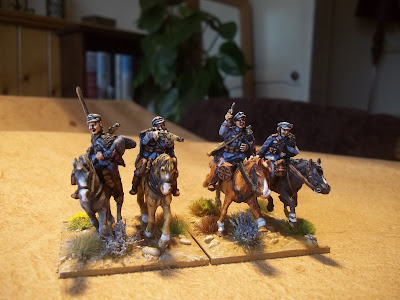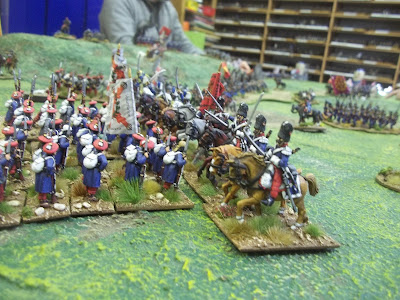So I thought I would do a post on my progress with this "side project" in some part to keep me going with it.
Polish Legion Cavalry
In 1919 with tensions growing between Soviet Russia and the newly formed country of Poland, Russia moved troops into the Ukraine and began a build up of troops. Poland realised they wouldn't be able to stop the Russians on the open plains of Poland and so decided on a pre emptive strike. Thus started the Russo Polish War, running consequtively with the Russian Civil War. The Russian plan was to over run Poland and then use this as a spring board to export Communism into Western Europe via Germany. It almost worked
Polish Lancers
What is particularly unusual and attractive to this period is that the Poles during WW1 had fought for the armies of Russia, Austria, Germany and France often in Polish only units up to Brigade or even Divisional level in the uniforms of those countries suitably modified to be a bit more Polish and in each case on the promise from that Power of Polish independence if they won.So you have an army that had a large portion of troops in French horizon blue, lots in German uniforms, some supplied after the war had ended, others in their Russian uniforms in which they had spent 1917 and 18 fighting the Bolshiviks as part of white forces in the Civil War and the Polish Legion which had fought in its own Polish uniforms in the Austrian army until they were disarmed.
Oh and lets not forget that in 1919 the Poles were raising new volunteer units wearing what was to become the standard grey green uniform of the Polish army
You can clearly see the German influence in this units uniform
The distances involved in the Russian Civil War and WW1 in the East meant that Cavalry still had a meaningful part to play in operations and this was a particularly strong arm in the new Polish army.
A home made Polish Tchanka machine gun cart
I started off with the Polish Uhlans of the Imperial Guard, Well who wouldn't? These fought through the first world war and the first years of the Russian Civil War before marching into the newly formed Poland in 1918. Now I have to admit to taking some liberties with thse guys.
Polish Guard Uhlans
Its pretty unlikely that they all wore officers greatcoats as depicted here. I do think they wore the cherry topped caps though, but I wont swear to that, in termr of the grey horses, hands up I just wanted to paint lots of grey horses. My bad.
These were the first poles I did as they fought in the Civil War so were useful for that army. I had painted 12 but only need eight per squadron hence why I deced to add another 4 and have two squadrons.
The bandaged head is a swap and comes from Gripping Beast
So when I decided to use Polish units proper the "Blue Army" seemed a good place to start. Basic French troops with a white eagle painted onto the helmet. I very soon got enthusiastic though and used Redoubt Miniatures caps to make square topped caps for these guys.
General Hallers Blue Army
Legionaaires
The Polish legion were a harder prospect and troops I really wanted to have until I found Siberia Miniatures. This company have specific figures for the conflict and Legion Cavalry are very nice indeed with the hussar jacket over the shoulder. The photo is of the first four I have finished, I will have one unit of eight cavalry for the legion.
Legion Foot
There were I think 2 divisions of the Legion, some of Polands best troops. The uniform s very Austrian in cut and colour but with a quite specific cap. As Siberia do separate heads for the Poles this came in very handy indeed.
More lancers to come.
I have now started work on more Lancers converted from renegade WW1 German cavalry and have also started to look at Gripping Beasts WW1 turks with separate heads to convert into Poles both for Legion and Volunteer units as below.
Work bench Legionaires using GB Turkish bodies.
There is a long way to go before I have enough for a decent game but I think this will be a really exciting collection when its done.
Thanks for reading. Great Northern War again next.......Honest!





































































